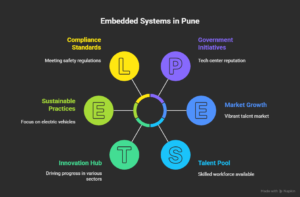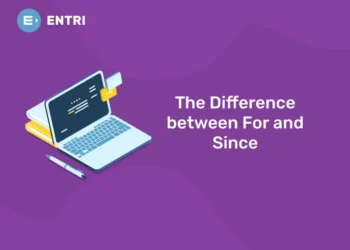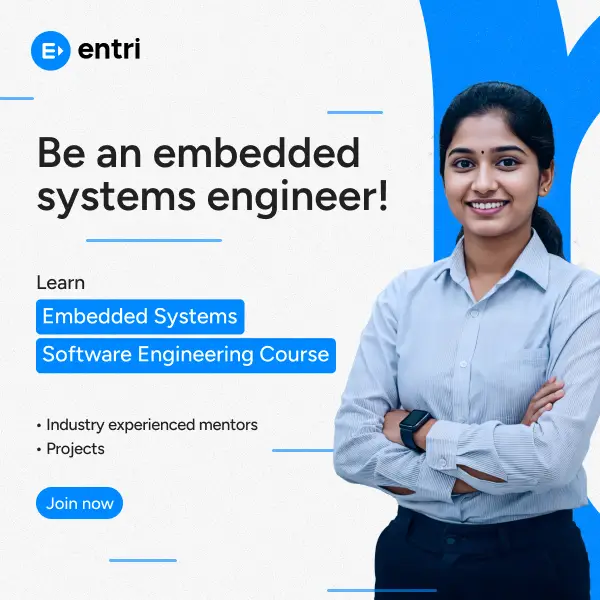Table of Contents
Imagine a world where your car predicts traffic jams, your watch tracks health in real time, and factories run without a hitch. These feats come from embedded systems, the hidden tech that powers everyday devices. Pune has become a hotspot for this field, drawing talent and investment from around the globe. Companies here build smart solutions for cars, health tools, and industrial machines. This growth stems from strong schools, skilled workers, and business-friendly policies. Readers will find value in learning about the top players shaping this sector.
The city offers a mix of big firms and fresh startups, each pushing boundaries in hardware and software. Job seekers can tap into roles that blend coding with real-world impact. Businesses gain partners for reliable tech needs. This post dives into the leading companies, job paths, and why Pune leads the way. Stick around to see how these firms create the future, one chip at a time.
Embedded systems combine hardware and software to perform specific tasks inside larger machines. They appear in cars for engine control, in medical devices for monitoring, and in home appliances for efficiency. Pune’s role grows as India aims for more tech exports. The sector here employs thousands, with demand rising for experts in coding languages like C and assembly. Companies invest in research to meet global standards. This setup makes Pune attractive for engineers and firms alike. The keyword “Top Embedded System Companies in Pune” captures the essence of this thriving hub. Readers interested in tech will discover firms that lead in innovation and quality. Each company brings unique strengths, from automotive focus to broad applications. The post outlines key players, their work, and how they contribute to the industry. Career sections highlight paths for growth and stability. By the end, readers will grasp why Pune deserves attention in embedded tech.
Kickstart your embedded systems career and turn your tech passion into high-demand skills!
Leading Embedded Systems Companies in Pune

Several firms stand out in Pune for their work in embedded systems. They range from giants with global reach to specialized outfits focused on niche solutions. Each contributes to the city’s reputation as a tech center. Descriptions below highlight their services, projects, and strengths. Keypoints list core features for quick reference. These companies drive progress in areas like automotive, healthcare, and consumer electronics. Their presence creates a vibrant market for talent and ideas. Businesses benefit from their expertise in custom designs and testing. Job hunters find roles that match skills in programming and hardware. Pune’s embedded scene thrives because of these leaders.
1. Tata Elxsi
Location: Hinjawadi and Magarpatta
Employee strength in Pune: ~4,500
Core work: Automotive ECUs, ADAS, infotainment systems, medical imaging devices
Tata Elxsi runs two large campuses in Pune and keeps hiring 800–1000 embedded engineers every year. Teams here write low-level drivers for 32-bit and 64-bit controllers, develop AUTOSAR stacks, and test ISO 26262 safety code. Freshers start on bootloader or diagnostic stacks and move to camera or radar modules within two years. Average salary for 3–5 years of experience stands at ₹14–18 lakh per annum with good bonuses.
2. KPIT Technologies
Location: Hinjawadi Phase 3
Employee strength in Pune: ~6,000
Core work: Electric vehicle powertrain, autonomous driving software, diagnostics
KPIT grew fast after the 2019 split from Cummins. The Pune center leads battery management systems (BMS) and motor control units for Indian and German car makers. Engineers work on MISRA-C compliant code, model-based design with MATLAB/Simulink, and functional safety up to ASIL-D. Even junior engineers get to visit client sites in Germany after 18 months. Current openings show ₹12 lakh packages for freshers with strong C and microcontroller skills.
3. Wipro Embedded & Automotive
Location: Hinjawadi
Employee strength in Pune: ~3,200
Core work: Connected vehicles, telematics, digital cockpit
Wipro built a dedicated automotive center in Pune that serves Ford, Volvo, and Indian OEMs. Teams handle hypervisor development, Android Automotive OS ports, and over-the-air update systems. The lab has its own vehicle fleet for testing. Experienced engineers earn ₹20–28 lakh when they lead a full infotainment project.
4. L&T Technology Services (LTTS)
Location: Talawade and Hinjawadi
Employee strength in Pune: ~5,000
Core work: Industrial automation, medical devices, railway signaling
LTTS runs one of the largest medical device teams in Pune. Engineers design firmware for ventilators, patient monitors, and ultrasound machines. The industrial side works on PLC replacements using ARM Cortex-M and real-time Linux. Salary bands match the best in the city, and the company sends people onsite to the US and Europe often.
5. Texas Instruments India
Location: Magarpatta (new campus under construction)
Employee strength in Pune: ~800 and growing fast
Core work: Analog and digital chip validation, reference designs, driver development
TI opened a big design center in Pune in 2023 and plans to reach 2,000 employees by 2027. Teams validate new automotive and industrial processors before launch. Engineers get to touch real silicon early and write production-grade code. Starting package for freshers crosses ₹18 lakh with stock units.
6. Honeywell Technology Solutions
Location: Hadapsar
Employee strength in Pune: ~2,500
Core work: Aerospace avionics, building management systems, IoT gateways
Honeywell’s Pune lab develops flight control software and safety-critical code for Boeing and Airbus suppliers. The building automation team works on BACnet and Modbus stacks. Pay remains high, and the work culture stays stable even during market slowdowns.
7. Siemens Industry Software (formerly Mentor Graphics)
Location: Magarpatta
Employee strength in Pune: ~1,200
Core work: Nucleus RTOS, Sourcery CodeBench, automotive hypervisors
Siemens keeps the old Mentor embedded team intact. Engineers maintain one of the oldest commercial RTOS kernels and help car makers build virtual ECUs. The work stays deeply technical, and the brand opens doors abroad.
8. Continental Automotive India
Location: Talegaon and Baner
Employee strength in Pune: ~3,800
Core work: Braking systems, ADAS sensors, instrument clusters
Continental runs hardware-in-loop rigs and full vehicle test tracks near Pune. Software teams write low-level code for radar and lidar processing units. German work culture and European projects attract many engineers who want international exposure.
9. Bosch Chassis Systems / Bosch Global Software Technologies
Location: Aundh and Hinjawadi
Employee strength in Pune: ~4,000
Core work: ABS/ESP, steering systems, vehicle dynamics
Bosch never stopped growing in Pune. Teams develop safety-critical code that runs on millions of cars worldwide. The new BGST division focuses on software-defined vehicle architecture. Average tenure stays high because learning never stops.
10. Cyient
Location: Gera Commerzone, Kharadi
Employee strength in Pune: ~2,200
Core work: Aerospace DO-178C software, railway signaling, semiconductor validation
Cyient serves Airbus, Boeing, and Indian defense clients from Pune. The aerospace team follows strict certification processes. Engineers who love standards and documentation choose Cyient.
11. Varroc Engineering
Location: Chakan and Aurangabad Road
Employee strength in Pune region: ~1,800
Core work: Two-wheeler and four-wheeler lighting ECUs, body control modules
Varroc supplies Bajaj, TVS, and international bike makers. Embedded teams design cost-sensitive controllers that survive heat, dust, and vibration. Good place for hardware-plus-software engineers.
12. Mindtree (now LTIMindtree)
Location: Hinjawadi
Employee strength in Pune: ~2,500
Core work: Connected devices, industrial IoT, medical firmware
LTIMindtree runs large IoT projects from Pune. Teams build secure bootloaders and wireless stacks for smart meters and health devices.
13. eInfochips (an Arrow company)
Location: Magarpatta
Employee strength in Pune: ~1,000
Core work: Product engineering services, ASIC validation, video processing
eInfochips works as an extended arm for Qualcomm, NVIDIA, and AMD. Engineers get early access to new chips and reference boards.
14. Sasken Technologies
Location: Shivajinagar
Employee strength in Pune: ~700
Core work: Multimedia codecs, Android HAL, 5G modems
Sasken keeps a strong multimedia and communication stack team in Pune. Many alumni now lead startups.
15. PathPartner Technology (now part of KPIT)
Location: Baner
Core work: Camera drivers, ISP tuning, radar signal processing
PathPartner merged with KPIT but still runs camera and sensor teams separately. Great place for computer vision engineers.
Hidden Gems and Fast-Growing Names
These companies hire fewer people but pay well and give ownership:
- Embien Technologies (Kharadi) – Strong in medical and industrial
- Volansys / ACL Digital (Hinjawadi) – IoT gateways and cloud edge
- Sterlite Technologies – Optical communication firmware
- Sanmina – Medical and defense hardware design
- Visteon India – Cockpit electronics
- Harman Connected Services – Audio DSP and infotainment
Career Opportunities in Embedded Systems
Pune offers more embedded jobs than Bangalore in 2025 because land costs stay lower and talent pool keeps growing.
Current Salary Ranges (2025 data)
| Experience Level | Salary Range (₹ Lakh per annum) | Top-Paying Companies (examples) |
|---|---|---|
| Fresher (0–1 year) | 6 – 18 | Texas Instruments, KPIT, Tata Elxsi, Continental |
| 2–4 years | 12 – 22 | KPIT, Tata Elxsi, Bosch, Wipro Automotive |
| 5–8 years | 20 – 35 | Continental, Bosch, Tata Elxsi, Honeywell |
| 8+ years / Tech Lead | 35 – 60+ | Texas Instruments, Continental, Siemens, LTTS |
Most In-Demand Skills Right Now
- C programming with MISRA guidelines
- AUTOSAR Classic and Adaptive
- Functional safety (ISO 26262, IEC 61508)
- Linux device drivers and Yocto
- RTOS (FreeRTOS, Zephyr, ThreadX)
- UDS diagnostics and cybersecurity (HIS, TLS)
- Model-based design (MATLAB/Simulink)
- Rust for embedded (growing fast)
Companies fight for people who know ASPICE processes and can write clean requirements.
Best Companies for Freshers
- KPIT – Large training batch, quick client projects
- Tata Elxsi – Structured learning, good brand
- Texas Instruments – High pay, deep technical work
- L&T Technology Services – Medical domain exposure
Best Companies for Fast Growth
- Continental – Direct German projects
- Bosch – Global rotation possible
- Honeywell – Stable and respected
- Wipro Automotive – Big teams, many roles
Best Companies for High Pay
- Texas Instruments
- Tata Elxsi (senior roles)
- Continental (ADAS teams)
- Siemens (hypervisor teams)
Work-Life Balance Winners
- Honeywell
- Cyient
- Sasken
- LTTS (project dependent)
Startup Route
Many engineers leave big firms after 5–7 years and join product startups in Baner-Balewadi belt. Average equity plus salary packages cross ₹40–50 lakh easily when the product ships.
Kickstart your embedded systems career and turn your tech passion into high-demand skills!
Conclusion
Pune now hosts every kind of embedded work possible, from two-wheeler lighting controllers that cost ₹200 to ADAS systems worth crores. The city gives freshers high starting pay, mid-level engineers global projects, and seniors leadership roles with stock options. Talent demand will stay strong for the next decade because electric vehicles, medical devices, and factory automation all need more embedded brains.
Pick a company that matches your interest area, automotive, medical, industrial, or communication, and start applying today. The top embedded system companies in Pune keep multiple openings live every week. Update the resume, brush up C coding and microcontroller concepts, and send applications directly on company career pages. Most good offers come within two weeks when skills match current needs.
The next big career move waits in Pune’s embedded valley. Go claim it.
Master Embedded Systems Programming!
Launch your tech career with our Embedded Systems Course in Kerala, designed for hands-on learning and industry readiness.
Know MoreFrequently Asked Questions
Beyond the high salaries, what are the tangible long-term career benefits of working for a top embedded systems company in Pune?
While the competitive compensation is a major draw, the long-term career benefits are arguably more valuable. Working for a leader like Bosch, Continental, or Tata Elxsi provides unparalleled industry credibility. You gain hands-on experience with global standards like ISO 26262 (Functional Safety) and ASPICE, which are gold on a resume. These companies offer structured career paths, allowing you to grow from a firmware engineer to a technical architect or a project manager. Furthermore, you get exposure to the entire product development lifecycle—from concept and design to validation and deployment—on products that are used by millions worldwide. This holistic experience is difficult to replicate in smaller firms and positions you for global opportunities, often including on-site stints in Europe or the US.
I'm a fresher with a degree in Electronics/Computer Engineering. What does the typical interview process look like at companies like KPIT or Texas Instruments, and how can I best prepare?
The interview process for freshers is rigorous and multi-stage, designed to assess core fundamentals. It typically involves:
-
Online Aptitude Test: Covers quantitative ability, logical reasoning, and verbal skills.
-
Technical MCQ Test: Focuses on C programming, microcontrollers (8051, ARM Cortex-M), computer architecture, and basic digital electronics.
-
Coding Round: You’ll be asked to write and debug C programs on concepts like pointers, structures, bit manipulation, and algorithms.
-
Technical Interviews (2-3 Rounds): This is the core. Interviewers will dive deep into:
-
C Programming: Const, volatile, memory layout (stack vs. heap), pointers, and complex declarations.
-
Microcontrollers: Peripherals (UART, I2C, SPI), interrupts, RTOS concepts (semaphores, mutexes, message queues).
-
Projects: Be prepared to explain your academic/final year project in extreme detail.
-
-
HR Interview: To assess communication, attitude, and cultural fit.
Preparation Tip: Focus intensely on C. Solve problems on pointers and memory management. Build a small project using an ARM Cortex-M development board (like STM32 or Tiva C) and be ready to explain every line of code and hardware choice.
How crucial is knowledge of AUTOSAR and functional safety (ISO 26262) for securing a high-paying role in Pune's automotive embedded sector, and can I learn it on the job?
For the automotive sector, knowledge of AUTOSAR (AUTomotive Open System ARchitecture) and ISO 26262 is not just an advantage—it is often a mandatory requirement for roles beyond the entry-level. Companies like Continental, Bosch, and KPIT build their software architectures around AUTOSAR to ensure scalability, reusability, and compliance. Similarly, ISO 26262 is critical for developing safety-critical systems like brakes and steering. While large companies provide extensive training, they expect candidates to have a fundamental understanding. You cannot learn it entirely from scratch on the job for a senior role. To prepare: Utilize online resources and courses to understand the basic concepts of AUTOSAR layers (BSW, RTE, SWC) and the V-model development process of ISO 26262. This initiative will make you a significantly more competitive candidate.
With the rise of IoT and AI, how are Pune's embedded companies like L&T Technology Services and Mindtree integrating these technologies into traditional embedded systems?
Pune’s embedded landscape is rapidly evolving. Traditional firmware is now being fused with IoT and AI at the edge. For instance:
-
LTTS integrates sensors and connectivity into industrial machines and medical devices, enabling Predictive Maintenance. An embedded system in a factory machine can now collect vibration data, use a lightweight ML model on the device itself to detect anomalies, and send alerts via the cloud before a failure occurs.
-
LTIMindtree works on Connected Devices where embedded firmware in a smart meter not only reads consumption but also uses algorithms to detect theft or leaks and communicates securely over wireless protocols like LoRaWAN or NB-IoT.
This shift means embedded engineers are now also working on connectivity stacks (Wi-Fi, BLE, 5G), cloud protocols (MQTT), and even deploying tinyML models on microcontrollers, making the field more interdisciplinary than ever.
For an experienced professional, what is the realistic scope for negotiating a salary package, and what factors (beyond years of experience) truly influence the final offer?
For experienced professionals (5+ years), there is significant scope for negotiation. The final offer is influenced by a combination of factors:
-
Niche Skill Set: Expertise in a high-demand, low-supply area like AUTOSAR Adaptive, Radar Signal Processing, or Cybersecurity for ECUs can increase your value by 20-30%.
-
Domain Depth: Deep experience in a specific vertical (e.g., Automotive ADAS, Medical Imaging, Aerospace Avionics) is highly valued.
-
Proven Impact: Your ability to demonstrate past achievements, such as leading a project from concept to production, optimizing performance, or reducing costs, is critical.
-
Current Compensation & Offer in Hand: Having a competing offer is the strongest negotiating lever.
-
Certifications: Recognized certifications in functional safety (e.g., ISO 26262) can directly translate to a higher package.
When negotiating, articulate clearly how your specific skills and experience will solve the company’s immediate challenges and contribute to their roadmap.
Many companies mention "work-life balance." Which firms in Pune are genuinely known for it, and how does this balance manifest in the day-to-day work of an embedded engineer?
“Work-life balance” varies by project and team, but some companies have a stronger reputation for it. Honeywell, Cyient, and Sasken are often cited for maintaining more predictable hours. This manifests as:
-
Limited Weekend Work: Critical product launches may require extra hours, but it’s not a perpetual state.
-
Flexible Hours: Many offer flexible start and end times, accommodating personal commitments.
-
Respect for Personal Time: There is a cultural norm against late-night emails or calls unless for a genuine production emergency.
-
Stable Project Cycles: Unlike consumer software, embedded hardware projects have longer, more predictable cycles, which can reduce the “crunch time” associated with agile sprints. However, it’s crucial to note that even in these companies, balance can be project-dependent, and teams working on tight deadlines for global clients may experience periods of high intensity.
How does the embedded systems ecosystem in Pune, with its mix of MNCs and startups, compare to a traditional tech hub like Bangalore?
Pune has carved a distinct identity compared to Bangalore:
-
Focus Area: Bangalore is a hub for IT services and pure-play software product companies. Pune has a stronger focus on engineering and hardware-software integration, particularly in the automotive, industrial, and medical domains.
-
Talent Pool: Pune’s talent is often considered to have deeper core engineering fundamentals due to the proximity of premier colleges like COEP and a culture of engineering rigor.
-
Cost & Infrastructure: Pune offers a relative advantage in terms of lower cost of living and less traffic congestion, though this is changing. Its industrial belts (Chakan, Talegaon) are purpose-built for manufacturing and engineering.
-
Collaboration: The close proximity of OEMs (like Bajaj, Tata Motors) and Tier-1 suppliers (like Varroc) in and around Pune creates a collaborative ecosystem that is hard to find elsewhere, leading to faster innovation cycles.
What are the most common reasons an embedded engineer might leave a top company in Pune, and what are the "red flags" job seekers should watch for during interviews?
Common reasons for leaving include:
-
Stagnation: Being stuck on maintenance of a legacy product without opportunities to work on new technologies.
-
Bureaucracy: In large MNCs, processes can sometimes slow down innovation and decision-making.
-
Limited Onsite Opportunities: For some, international exposure is a key career goal.
During interviews, watch for these “red flags”: -
Vague Project Descriptions: If the interviewer cannot clearly explain the project, your role, or the technology stack, it indicates disorganization.
-
High Attrition Mention: Casually mentioning that the team is “stretched because many people left” is a major warning sign.
-
Lack of Technical Depth: If the technical interview is too easy and doesn’t challenge you, it might mean the work is not intellectually stimulating.
-
Focus Only on Hours: Questions about willingness to work long hours regularly, rather than on innovation or problem-solving, signal a poor work culture.
With the consolidation in the industry (e.g., PathPartner merging with KPIT), how does this impact job stability and career growth for engineers in these companies?
Consolidation, like the KPIT-PathPartner merger, is a double-edged sword. Initially, it can create uncertainty regarding role duplication and reporting structures. However, for engineers, it often leads to:
-
Enhanced Stability: A larger, more diversified company is more resilient to market fluctuations.
-
Broader Opportunities: You get access to a larger portfolio of projects and technologies. A PathPartner engineer can now work on KPIT’s powertrain projects, and vice-versa.
-
Clearer Growth Paths: Larger organizations typically have more defined career ladders for both technical and managerial tracks.
The key is to be proactive. During such transitions, articulate your skills, seek out new challenges within the merged entity, and leverage the expanded network to find a role that aligns with your growth ambitions.
For someone looking to transition into the embedded systems field from a related IT domain (like application development), what is a realistic pathway to break into one of these top Pune companies?
Transitioning is challenging but achievable with a strategic approach:
-
Bridge the Skill Gap: You must master the fundamentals that IT often abstracts away: C Programming, Microcontroller Architecture, and Real-Time Systems. Online courses and books are essential.
-
Hands-On Projects are Non-Negotiable: Build a portfolio of projects using popular development boards (e.g., STM32, ESP32). Focus on interfacing with sensors, using communication protocols (I2C, SPI), and potentially running a small RTOS like FreeRTOS.
-
Target the Right Roles: Don’t apply for core automotive roles immediately. Look for positions in IoT (LTIMindtree, Volansys) or consumer electronics where knowledge of higher-level languages (Python, JavaScript for cloud connectivity) can be an advantage alongside your newly acquired embedded skills.
-
Leverage Your Domain Knowledge: If you come from a healthcare IT background, target embedded roles in medical device companies like LTTS where your domain understanding of data and regulations is a unique asset.
-
Be Prepared for a Salary Reset: You may need to join at a slightly junior level to build credibility, with the long-term goal of rapidly advancing as you accumulate embedded-specific experience.













